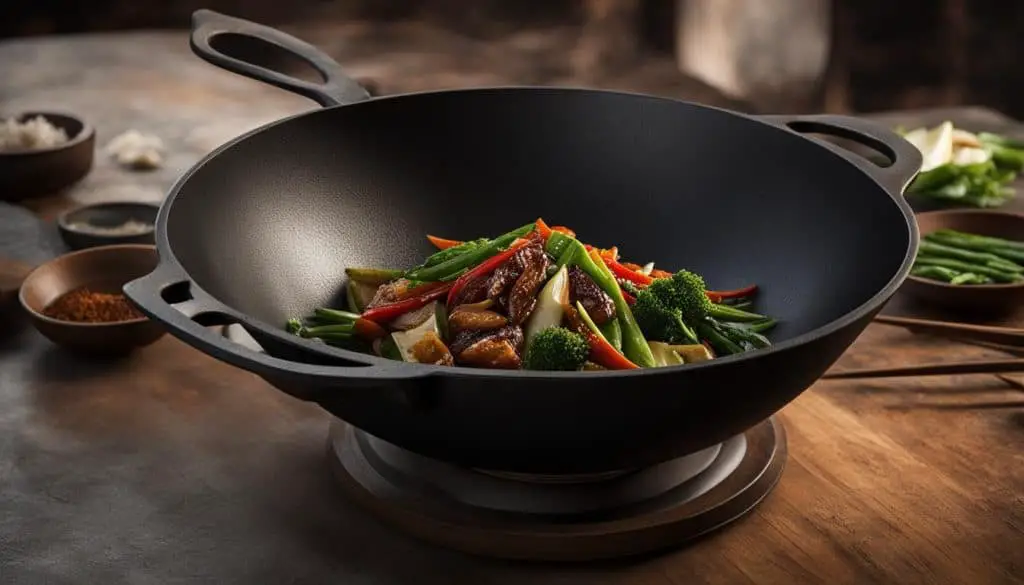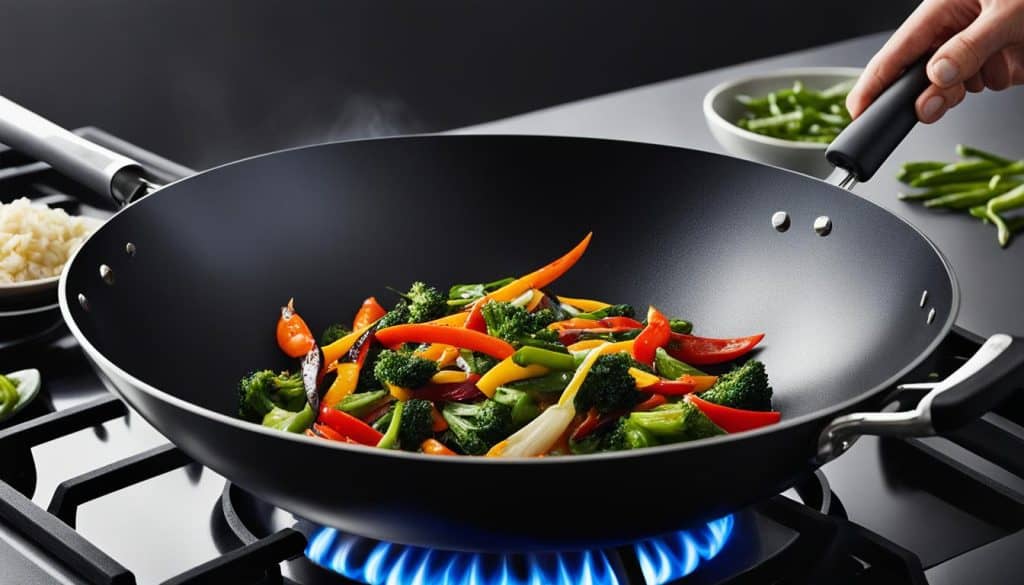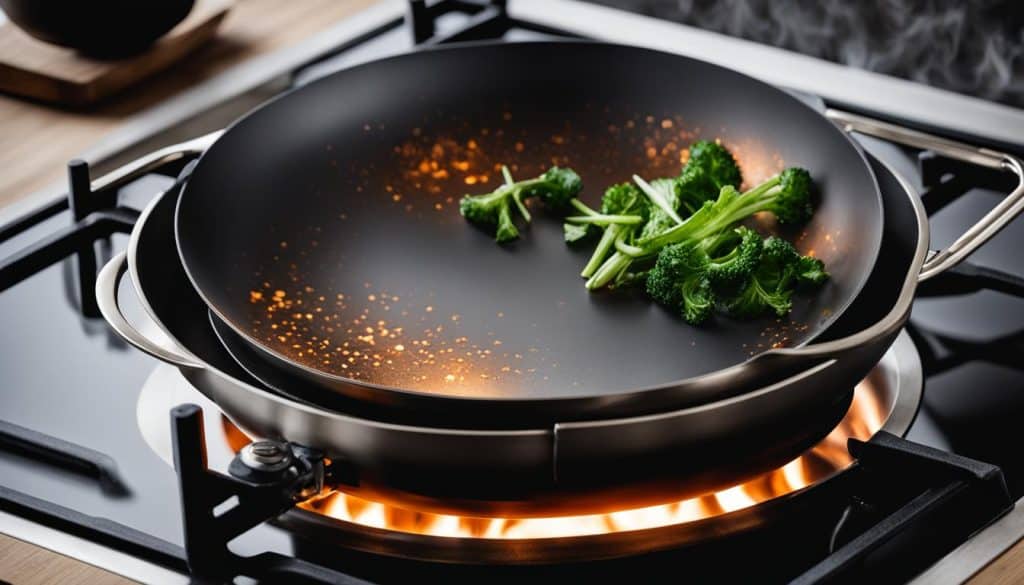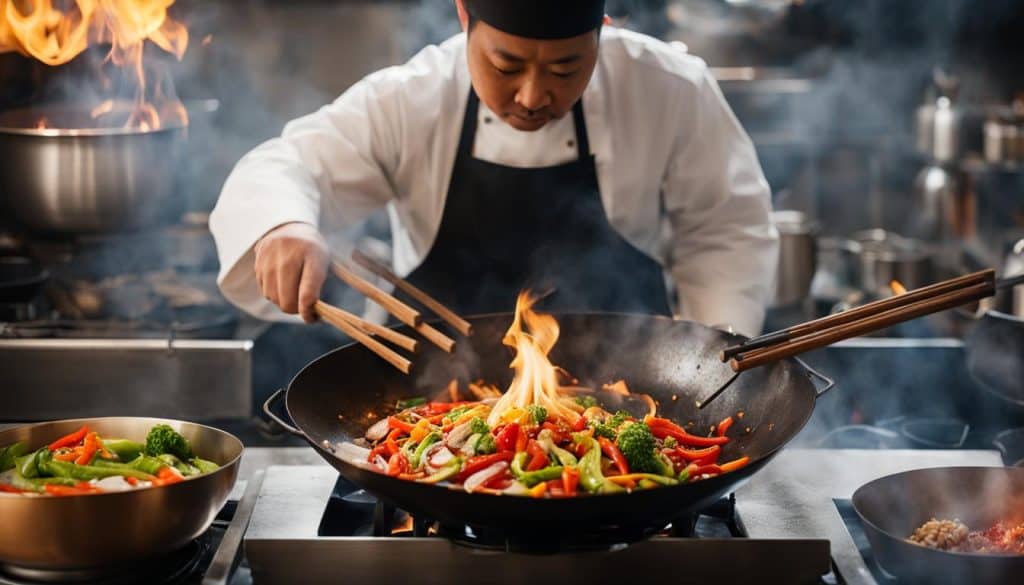If you’re a stir-fry enthusiast or a fan of Asian cuisine, then owning a wok should be a top priority in your kitchen. Woks are versatile and can be used for a variety of cooking techniques such as steaming, braising, and deep-frying. But with so many types of woks, materials, and shapes available, it can be overwhelming to choose the right one for you.
In this article, we will explore the different Types of Woks available in the market. From carbon steel to cast iron, stainless steel to nonstick, we’ll explain the unique characteristics of each material and shape and how it affects your cooking, including how to achieve the coveted wok hei flavor.
So whether you’re a seasoned chef or new to cooking, continue reading to find the perfect wok for your kitchen.
Carbon Steel Woks
When it comes to woks, carbon steel woks are a top choice for home cooks and professional chefs alike. Their excellent heat conduction and durability make them a staple in many kitchens. Furthermore, they are highly affordable compared to other types, making them accessible to all budgets.
However, unlike non-stick options, carbon steel woks need to be seasoned before use to build a natural non-stick coating. The seasoning process takes a bit of effort but enhances the wok’s cooking performance, preventing ingredients from sticking. Seasoning also gives the wok a unique flavor over time.
Considering their superior heat conduction and affordability, it’s no surprise that carbon steel woks are a fan favorite of many home cooks. But it’s important to note that carbon steel woks, like all woks, have their drawbacks. For example, their non-stick coating may not last as long as other options, so it’s essential to season them regularly to ensure continued performance.
Cast Iron Woks
If you’re in search of a wok that not only heats up quickly but also retains heat exceptionally well, then cast iron woks are a top contender.
The even heating of cast iron woks makes it an excellent option for recipes that require slow cooking or braising, and unlike steel or aluminum, it doesn’t need to be made extra thick to enhance heat retention. Cast iron woks may take longer to heat up, but once warmed up, you can count on it to keep your meal hot for a long time.
Due to its weight, cast iron woks require seasoning before use. This process involves rubbing the surface with oil and baking it in the oven or on the stove to develop a natural non-stick seasoning layer.
The wok will get better with time and use as the seasoning only gets stronger. However, the process can be overwhelming for first-time users.
Cast iron woks are also incredibly versatile, and they can be used for deep-frying, pan-frying, stir-frying, and searing. They may not be the easiest wok to maneuver, but once you get the hang of it, you will have a powerful tool in your kitchen arsenal.

Cast Iron Wok vs. Carbon Steel Wok: Which is Better?
Both cast iron and carbon steel woks have their strong suits. However, when it comes to even cooking and retaining heat, cast iron woks win over carbon steel woks. Although they may have a longer heating time, once the wok heats up, it maintains the heat for a long time.
On the other hand, carbon steel woks are a better choice if you’re looking for a lightweight option and easy maneuverability. They don’t require much time to season and are ready to use after a simple wash with soap and water.
| Cast Iron Wok | Carbon Steel Wok |
|---|---|
| Retains heat exceptionally well | Lightweight and easy to maneuver |
| Heavy and requires seasoning | Requires minimal seasoning and only needs soap and water for cleaning |
| Extremely versatile | Great for tossing and stir-frying |
| Has a longer heating time | Heats up quickly |
A cast-iron wok is one of those things that once you use, it becomes a workhorse in the kitchen.
Sherry Yard
Overall, cast iron woks are an excellent investment for any home cook who wants a versatile and durable cooking tool. Its diverse temperature range makes it a great tool for a variety of cooking techniques, from deep-frying to sautéing. Cast iron woks are also durable and can last for a long time with proper care and maintenance.
Stainless Steel Woks
Stainless steel woks are a popular choice due to their rust resistance, corrosion resistance, and easy maintenance. They are perfect for those who prefer a hassle-free cleaning experience and wish to avoid rust and corrosion build-up.
Stainless steel woks are sturdy and durable, but they don’t conduct heat as effectively as carbon steel or cast iron woks. This can affect the cooking experience, as stainless steel woks may take longer to heat up and may not distribute heat evenly across the surface.
On the other hand, stainless steel woks offer excellent versatility and are compatible with all types of stovetops, including induction cooktops. They are also dishwasher-safe, making them ideal for those who prefer to avoid washing dishes by hand.
Tip: To improve the heat conduction of stainless steel woks, look for models that feature a tri-ply or multi-ply base. These woks have an additional layer of aluminum or copper sandwiched between two layers of stainless steel, resulting in better heat distribution.
Nonstick Woks
If you’re someone who values easy cleanup and doesn’t want to spend time seasoning your wok, a nonstick wok could be a great fit for you. With a nonstick coating, food will slide right off, making cleanup a breeze.
However, keep in mind that nonstick coatings don’t fare well with high-heat cooking, which is essential for achieving that coveted wok hei flavor.
If you do decide to opt for a nonstick wok, make sure to choose one with a durable nonstick coating to avoid it from degrading over time. It’s also important to note that using metal utensils on a nonstick coating can cause damage, so stick to wooden or silicone utensils instead.

If you’re looking for a table that compares nonstick woks to other types of woks, check out the table below:
Comparison Table: Nonstick vs Other Types of Woks
| Feature | Nonstick Woks | Carbon Steel Woks | Cast Iron Woks |
|---|---|---|---|
| Easy Cleanup | Excellent | Good | Fair |
| High-Heat Cooking | Poor | Excellent | Good |
| Wok Hei Flavor | Poor | Excellent | Good |
| Nonstick Coating | Yes | Seasoning Required | Seasoning Required |
Aluminum Woks
If you’re looking for a lightweight wok that heats up quickly, an aluminum wok may be the right choice for you. The material is known for its impressive heat conductivity, allowing your food to cook evenly and quickly.
However, it’s important to keep in mind that aluminum woks are less durable than other materials, such as carbon or cast iron. They are also prone to warping, especially if exposed to high temperatures.
Another consideration is the reactivity of aluminum with acidic ingredients, which can cause a metallic taste in your food. To prevent this, it’s recommended to avoid cooking acidic foods in aluminum woks or to use a non-reactive lining.
If you do decide to go with an aluminum wok, look for one with a thicker gauge to help prevent warping and ensure better durability.

Aluminum Woks Pros and Cons
| Pros | Cons |
|---|---|
| Lightweight and easy to handle | Less durable than other materials |
| Quick heating and excellent heat conductivity | Prone to warping |
| Affordable compared to other materials | Reacts with acidic ingredients causing a metallic taste |
Make an informed decision and weigh the pros and cons carefully before purchasing an aluminum wok. Consider your specific cooking needs and habits to help determine if this is the right material for you.
Round-Bottomed Woks
If you’re looking for a wok that can enhance your stir-frying skills and deliver the smoky wok hei flavor, round-bottomed woks are your perfect match. These woks boast a traditional shape designed for use over open flames or with wok rings, which ensures even heat distribution and excellent heat retention.
This makes them ideal for stir-frying at high temperatures, which seals in flavors and gives stir-fry dishes that signature smoky taste.
With round-bottomed woks, the heat is concentrated at the bottom, and the sides are angled to provide an ideal shape for tossing ingredients. They also feature a small handle on one side and a long handle on the other to make handling and lifting easier.
While round-bottomed woks aren’t compatible with flat cooktops, they’re perfect for gas stovetops and outdoor grills. Try out these versatile woks to perfect your stir-fry game and enjoy delicious Chinese-inspired dishes.

Flat-Bottomed Woks
Are you looking for a wok that can be used on your electric or induction stovetop? Look no further than the flat-bottomed wok.
These woks are designed to sit directly on flat cooktops, making them more compatible with modern kitchens. Unlike traditional round-bottomed woks, the flat-bottomed wok can be used with ease on any flat surface.
However, it’s essential to keep in mind that flat-bottomed woks may not distribute heat as evenly as round-bottomed woks. For this reason, it’s crucial to choose a wok made with high-quality materials that promote even heat distribution.

When choosing a flat-bottomed wok, pay attention to the material. Carbon steel and cast iron woks are excellent options due to their durability and heat conduction.
Stainless steel woks are also a popular choice due to their rust and corrosion resistance. However, they may not conduct heat as effectively as other materials.
With proper care and maintenance, a flat-bottomed wok can be a valuable addition to your kitchen. It will allow you to enjoy stir-frying and other traditional wok cooking techniques without having to worry about compatibility.
Cantonese Woks
If you’re looking for a wok that can help you with steaming, braising, stir-frying, and more, Cantonese woks could be the perfect addition to your kitchen. These woks often have loop handles on both sides, which helps with lifting and maneuvering, making them easier to use.
As with all woks, it’s essential to pay attention to the materials and construction. Cantonese woks are often made from materials like carbon steel or cast iron, as these offer excellent heat retention and even distribution.
If you plan on using your Cantonese wok for steaming or braising, you may want to consider investing in a steaming rack. This accessory sits above the water in the wok and allows you to cook delicate foods like dumplings or fish without burning them or losing their flavor.

Overall, Cantonese woks are a versatile and practical choice for any home chef. Whether you’re looking to stir-fry vegetables or steam fish, these woks can help you achieve delicious results with ease.
Mandarin Woks
Looking for a wok that is perfect for stir-frying and tossing ingredients? Consider getting a mandarin wok. It features a long handle with a helper handle on the opposite side, allowing you to easily maneuver and control the pan as you cook.
In a mandarin wok, you can quickly and evenly heat ingredients, achieving the delicious wok hei flavor typical of stir-fried dishes. Its design also makes it easier to toss the ingredients, keeping them moving and preventing them from sticking to the pan.

Whether you’re a professional chef or a home cook, a mandarin wok can be a great addition to your kitchen. It may take some practice to master the art of stir-frying, but with a mandarin wok, you’ll be well on your way to creating restaurant-quality dishes in no time.
Additional Varieties of Woks
While carbon steel, cast iron, stainless steel, and aluminum woks are the most widely used, there are other types of woks available that cater to specific needs.
Electric woks are a type of self-contained cooking unit that comes with a built-in heating element, eliminating the need for a separate stove or burner. They offer convenience and allow you to control the temperature for precise cooking. If you’re looking for a compact and portable option, an electric wok may be the perfect fit for you.
Pow woks are specialized woks that feature a single long handle, allowing you to toss ingredients and achieve the coveted wok hei flavor. They are designed for high-temperature cooking and are ideal for stir-frying.
Copper woks are excellent heat conductors and are perfect for achieving wok hei. However, copper is a reactive metal that requires careful maintenance to prevent discoloration and pitting. Copper woks are often expensive and may not be the best choice for everyday use.
When choosing a wok, consider the type of cooking you’ll be doing and the materials and shapes that will best suit your needs. Regardless of which type of wok you choose, proper care and maintenance will ensure its longevity and performance for years to come.


